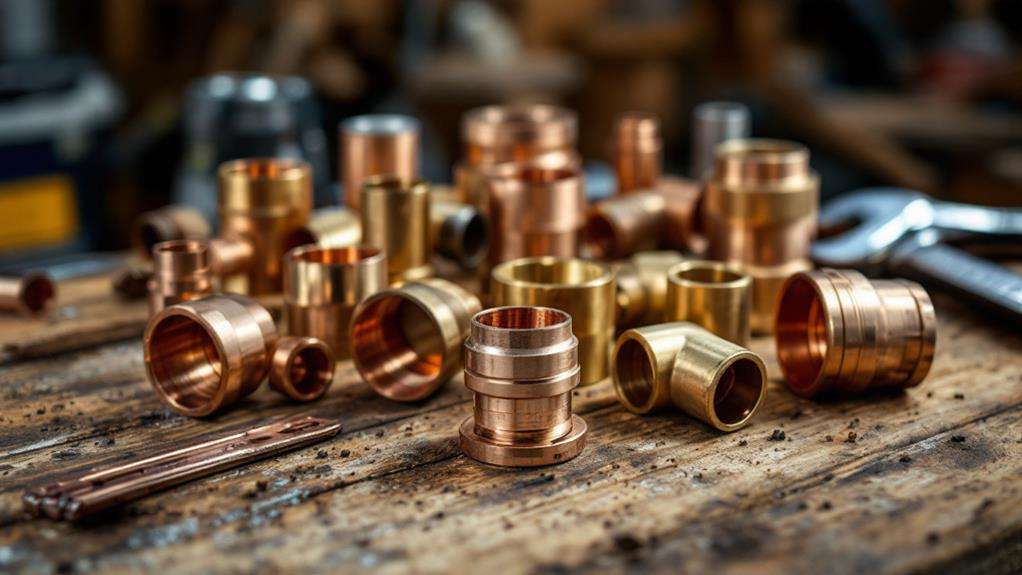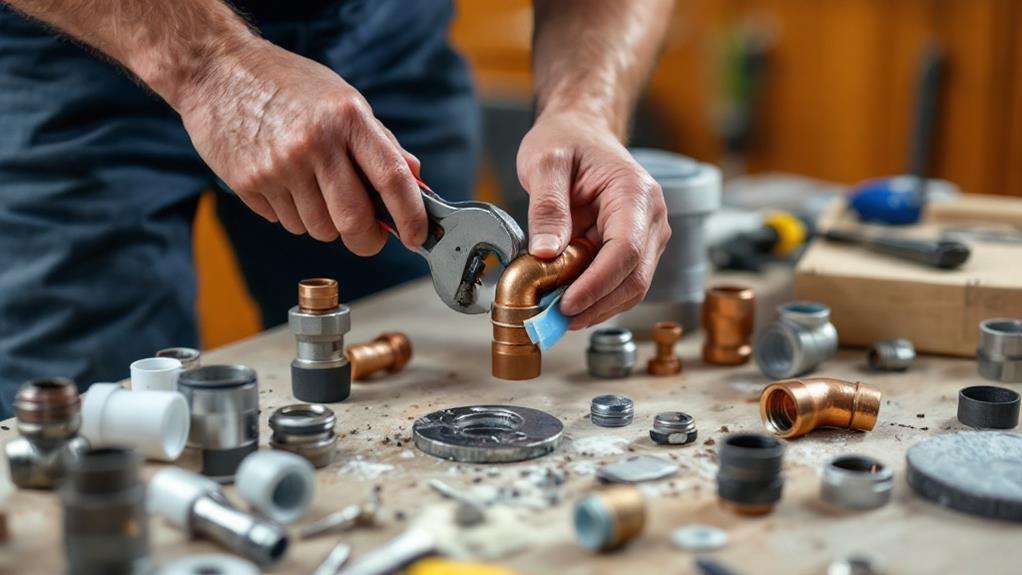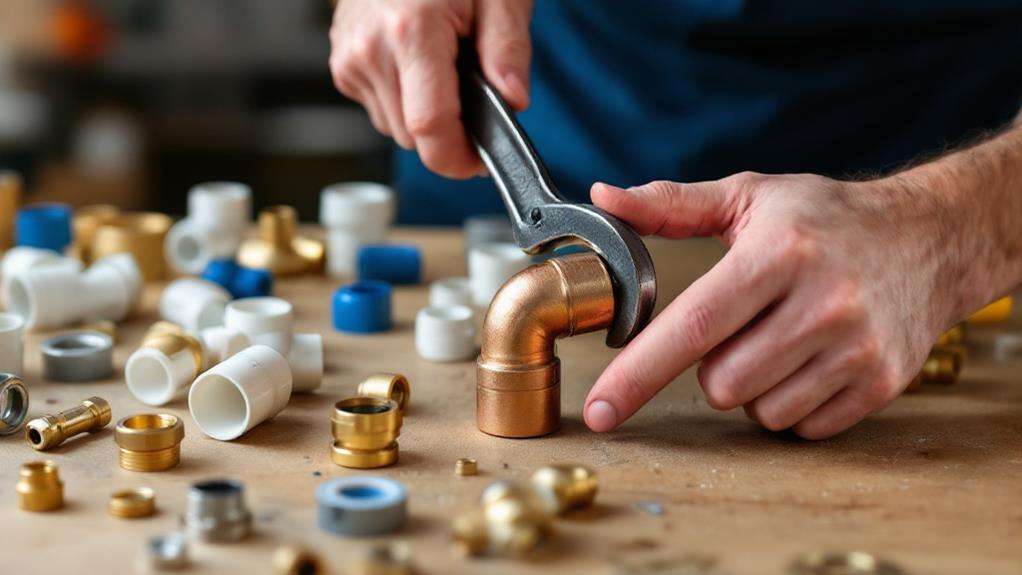Pipe Fittings and Adapters: An Essential Guide for DIY Plumbing
Pipe fittings and adapters are vital for DIY plumbing projects, allowing you to connect, redirect, and modify pipes effectively. You'll encounter various types, including elbows, tees, and couplings, made from materials like copper, PVC, or brass. To choose the right adapter, consider pipe diameter, thread type, and material compatibility. Essential tools like tube cutters and pipe wrenches will help you install fittings properly. When connecting fittings, use appropriate techniques such as solvent welding or soldering. Regular maintenance and proper troubleshooting can prevent leaks and maintain system dependability. By understanding these basics, you'll be well-equipped to tackle your next plumbing project with confidence.
Understanding Common Pipe Fitting Types
Several essential pipe fitting types are indispensable for any plumbing or piping system. When working on your plumbing projects, you'll encounter various fittings designed to serve specific purposes. Elbows, available in 90-degree and 45-degree angles, are crucial for changing the direction of flow in your pipes. You'll use these frequently when navigating corners or obstacles in your plumbing system.
Tees, both equal and reducing, play a key role in splitting or combining flow. They're essential when you need to branch off your main line or merge multiple pipes. Couplings, including straight and reducing types, allow you to connect pipes of the same or different diameters seamlessly.
For areas that may require future maintenance or modifications, unions are your go-to fitting. These three-part components enable easy disconnection and reconnection of pipes, saving you time and effort during repairs.
Lastly, adapters are essential for transitioning between different types of connections. Available in male and female varieties, they're indispensable when you need to connect pipes to various fittings or equipment. By understanding these common pipe fittings and adapters, you'll be better equipped to tackle your DIY plumbing projects effectively.
Materials Used in Plumbing Fittings
When you're selecting materials for your plumbing fittings, you'll need to ponder various factors to safeguard the best performance and longevity of your system. The most common materials include copper, brass, PVC, CPVC, and galvanized steel, each with its own strengths and ideal applications.
Copper fittings and brass fittings are excellent choices for durability and corrosion resistance. You'll find these materials particularly suitable for hot water applications, where their sturdy nature shines. If you're working on cold water, drain, or irrigation systems, consider PVC fittings. They're lightweight, cost-effective, and perform well in these scenarios. CPVC, a close relative of PVC, offers similar benefits.
It's important to note that galvanized steel fittings, while once popular, are now discouraged for new installations due to their susceptibility to corrosion. When making your selection, consider factors like water temperature, the material of the pipes you're connecting, and the specific requirements of your plumbing project. By matching the right fitting material to your needs, you'll achieve a more efficient and long-lasting plumbing system.
Choosing the Right Adapter

In the domain of plumbing, selecting the appropriate adapter is crucial for confirming a proper fit and leak-free connection. Adapters are used when you need to connect pipes or fittings of different sizes, materials, or threading types. To choose the right adapter, you'll first need to identify the specifications of the pipes or fittings you're working with.
Start by measuring the diameter and thread type of both ends you're trying to connect. You'll also need to determine if you're dealing with male or female threads. Once you have this information, you can select an adapter that matches both sides. Remember, adapters come in various configurations, such as male-to-female, female-to-female, or male-to-male.
Consider the material of your existing plumbing and choose an adapter that's compatible. If you need to move from one material to another, look for adapters specifically designed for this purpose. Don't forget to check the pressure rating of the adapter to confirm it can handle your system's demands. When in doubt, consult a plumbing professional or refer to local building codes to confirm you're using the correct adapter for your specific application.
Essential Tools for Fitting Installation
Having selected the right adapter, you'll need the proper tools to install it correctly. A tube cutter is indispensable for achieving clean, even cuts on pipes before joining them with fittings. This precision guarantees a tight, leak-free connection. You'll also want a pipe wrench in your toolkit. It provides the necessary force to tighten threaded fittings securely without damaging the pipe material.
For working in tight spaces or creating smooth bends in flexible piping like copper or PEX, a tubing bender is essential. It allows you to maneuver around obstacles without compromising the integrity of your plumbing system. Don't forget about surface preparation tools, such as flux brushes and emery cloth. These help you properly prepare pipe surfaces for soldering or cementing fittings, ensuring a strong and leak-proof seal.
When dealing with hard-to-reach fittings under sinks or behind fixtures, an adjustable basin wrench becomes your best friend. This specialized tool allows you to tighten and loosen fittings in confined spaces where standard wrenches can't reach. By having these essential tools on hand, you'll be well-equipped to tackle various fitting installation tasks with confidence and precision.
Proper Techniques for Connecting Fittings

Connecting pipe fittings properly can make or break your plumbing project. When working with PVC or CPVC pipes, you'll want to use solvent welding for a permanent, leak-proof seal. This technique creates a strong bond that's necessary for long-lasting installations.
For more flexibility, consider using threaded fittings like male and female adapters. These allow you to easily install and dismantle pipes, which is ideal if you're planning future modifications. Don't forget to apply the appropriate sealant, such as Teflon tape or pipe dope, to guarantee a tight seal and prevent damage to the threads.
If you're working with copper pipes, you'll need to become proficient in the solder method. This involves heating the joint and applying lead-free solder to create a durable, corrosion-resistant connection. It's a bit more advanced, but it's pivotal for proper copper pipe installation.
For DIY projects, compression fittings are a great option. They're versatile and don't require specialized tools or heat, making them perfect for connecting various pipe materials. Whether you're a beginner or an experienced DIYer, compression fittings offer a simple solution for many plumbing tasks.
Troubleshooting Common Fitting Issues
Leaks, mismatched threads, and improper connections can turn your plumbing project into a nightmare. When troubleshooting fitting issues, start by correctly identifying the type of connection on your water valve. Is it compression or threaded? This vital step guarantees you'll select compatible fittings, preventing leaks and damage.
If you're dealing with different pipe thread types like BSP and NPT, don't try to force incompatible fittings together. Instead, find the right adapter designed for your specific connection. For potable water systems, avoid unknown or unbranded fittings to ascertain lead-free, compatible materials.
To minimize potential problems, reduce the number of connections and adapters in your setup. This approach simplifies installation and decreases the risk of leaks. If you're unsure about which fittings to use, don't hesitate to consult plumbing supply experts or check the appliance manufacturer's recommendations.
Maintaining and Replacing Pipe Fittings

Once you've successfully troubleshot and resolved fitting issues, it's important to focus on maintaining your plumbing system for long-term reliability. Regularly inspect your pipe fittings for signs of wear, corrosion, or damage. This proactive approach can help you identify potential problems before they escalate into costly repairs or water damage.
When you notice worn or damaged fittings, don't hesitate to replace them. Replacing fittings is essential for preventing leaks and maintaining the integrity of your plumbing system. As you select new fittings, make sure they match the material, size, and type of your existing pipes. This compatibility is crucial for creating a proper, leak-free connection.
Always keep local building codes and regulations in mind when choosing and installing replacement fittings. Compliance with these standards is vital to avoid potential issues down the line. If you're unsure about the proper fitting selection or installation process, especially for complex projects, don't hesitate to consult a professional plumber. Their expertise can be invaluable in ensuring your plumbing system remains in top condition and functions efficiently for years to come.
Safety Considerations for DIY Plumbing
A DIY plumber's safety should always be the top priority when working with pipe fittings and adapters. As a DIY enthusiast, you must be aware of the potential hazards associated with plumbing systems and take necessary precautions.
First, ensure you're familiar with local building codes and obtain required permits before starting any project. Always wear protective gear, including safety glasses, gloves, and sturdy footwear. When working with pipes, be cautious of sharp edges and burrs that can cause cuts. If you're soldering, use heat-resistant gloves and keep a fire extinguisher nearby.
Be mindful of the materials you're working with. Some older pipes may contain lead or asbestos, which require special handling. If you suspect hazardous materials, consult a specialist. When working on existing plumbing, shut off the main water supply and drain the pipes before making any modifications.
Proper ventilation is essential, especially when using adhesives or solvents. Work in a well-ventilated area and use a respirator if necessary. Finally, know your limits. If a job seems too complex or risky, don't hesitate to call a professional plumber. Your safety is worth more than any potential savings from DIY work.
